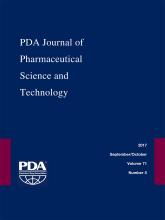Abstract
Recombinant Factor C (rFC) is non-animal-derived reagent used to detect bacterial endotoxins in pharmaceutical products. Despite the fact that the reagent was first commercially available nearly 15 years ago, the broad use of rFC in pharmaceutical industry has long been lagging, presumably due to historical single-source supplier concerns and the lack of inclusion in worldwide pharmacopeias. Commercial rFC reagents are now available from multiple manufacturers, thus single sourcing is no longer an issue. We report here the successful validation of several pharmaceutical products by an end-point florescence-based endotoxin method using the rFC reagent. The method is equivalent or superior to the compendia bacterial endotoxins test method. Based on the comparability data and extenuating circumstances, the incorporation of the end point fluorescence technique and rFC reagent in global compendia bacterial endotoxins test chapters is desired and warranted.
LAY ABSTRACT: Public health has been protected for over 30 years with the use of a purified blood product of the horseshoe crab, limulus amebocyte lysate. More recently, this blood product can be produced in biotech manufacturing processes, which reduces potential impacts to the horseshoe crab and related species dependent upon the crab, for example, migrating shorebirds. The pharmaceutical industry has been slow to adopt the use of this reagent, Recombinant Factor C (rFC), for various reasons. We evaluated the use of rFC across many pharmaceutical products, and in other feasibility demonstration experiments, and found rFC to be a suitable alternative to the animal-derived limulus amebocyte lysate. Incorporation of rFC and its analytical method into national testing standards would provide an equivalent or better test while continuing to maintain patient safety for those who depend on medicines and while securing pharmaceutical supply chains. In addition, widespread use of this method would benefit existing animal conservation efforts.
- © PDA, Inc. 2017
PDA members receive access to all articles published in the current year and previous volume year. Institutional subscribers received access to all content. Log in below to receive access to this article if you are either of these.
If you are neither or you are a PDA member trying to access an article outside of your membership license, then you must purchase access to this article (below). If you do not have a username or password for JPST, you will be required to create an account prior to purchasing.
Full issue PDFs are for PDA members only.
Note to pda.org users
The PDA and PDA bookstore websites (www.pda.org and www.pda.org/bookstore) are separate websites from the PDA JPST website. When you first join PDA, your initial UserID and Password are sent to HighWirePress to create your PDA JPST account. Subsequent UserrID and Password changes required at the PDA websites will not pass on to PDA JPST and vice versa. If you forget your PDA JPST UserID and/or Password, you can request help to retrieve UserID and reset Password below.






